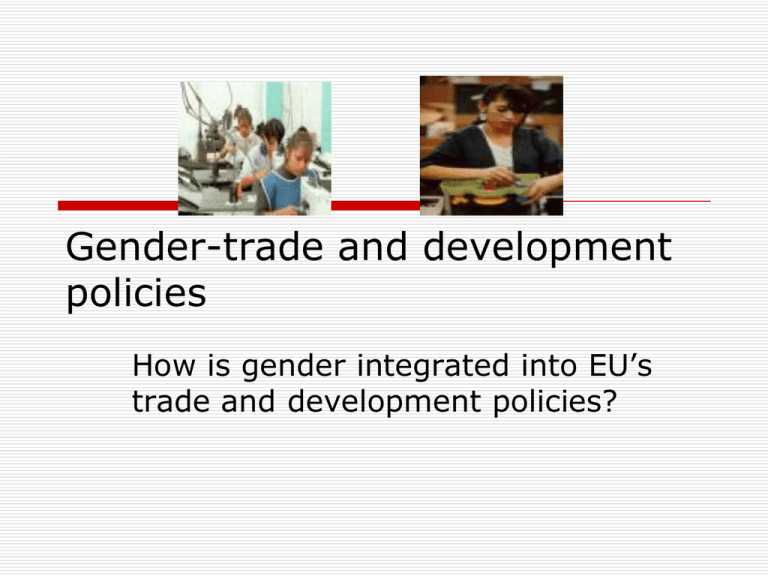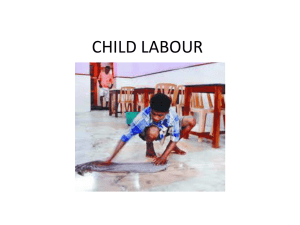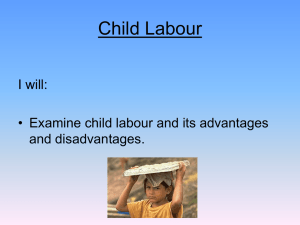
Gender-trade and development
policies
How is gender integrated into EU’s
trade and development policies?
Gender: a controversial
concept
Debate ”Nature vs educationsocialization”
From social biology (sex as part of
nature) to: gender as a product of
socialization
Gender as a socially/contextualized
interpretation of biological sex, as a
social construction of sex
Globalization and SAP
Two faces of economic restructuring
The export model-to find new nichesto be exported at any cost
Foreign trade and foreign investmentthe new key words in the
globalization era
SAP-measures and women
SAP and women-taking from the statesocial care responsibilities-putting them on
women
Reduction of fiscal deficits, promotion of
export oriented industrial and agriculture
production and attraction of direct
investment-less jobs and less income
Opening of the economies-no more industry
protection or subsidies
Privatization-selling state assets and
infrastructure (like energy production
communication, etc)
SAP: consequences
Poor and small farmers neglectedfood sovereignty –forgotten
Small and middle national
enterprises-sacrificed to international
competitiveness (ISI-gains erased)
Middle classes-impoverished and poor
groups-specially women-very affected
Reactions: fundamentalism-religious
and cultural: anti-westernization
The ”maquiladora model” and
women
The global chain production: at the
search of cheap, docile and unorganized
labour
Women the majority of the workers in
low-skilled, labor-intensive sectors,
concentrated in the lower segments of
the occupational hierarchies,
Particularly vulnerable to individual and
structural discrimination and abuse
Women (or feminisation of cheap labour)
as a motor into globalization
Women-are forced to go into the
labour market to make ends meet:
women and feminisation of export
jobs as the reserve army of labour for
export competitivenessunderpaid workers in all low
wage export industries (industrial
and agro-export) in the global
South
Globalization and women
Moreover: women workers in the
informal sector-used and abused by the
global chain production: as easy prey to
sub-contractors
Flexibilization-a way to make production
more efficient- putting more and more
formal work into the informal market
Service sector-more and more informal
Applying a gender perspective to
trade policies
Applying a gender perspective to
trade policies means overcoming the
divide between social and economic
policies, giving access to affordable
essential services and social security,
and enforcing women’s and poor
people’s right to food, health,
education and livelihoods
Some consequences of trade
Export model in outsourcing products
and services-women as workers
Privatisation: resources and services
More women in the informal sector
women as migrants: 50-95% of all
migrants in the world: import of
maids, traffiking-prostitution, bridepost orders, sexual tourism.
Trade liberalisation in agriculture
Livelihoods and food security:
favours the development of large-scale
commercial, input-intensive, exportoriented farming
undermine small-scale farming for
subsistence or local markets, which has
been based on biodiversity, indigenous
knowledge systems and exchange of local
seeds, mostly done by women
Trade liberalization in agriculture-2
It encourages consolidation of land
holdings, monocultures and the
introduction of machinery, while women
still struggle to gain land rights and access
to credit, technology and information.
leads to the depletion of common land and
state forests, which were used by women
for collection of fuel, fodder, water, oil
seeds and fruit, as well as roots and herbs
for nutritional and medical purposes.
Also: women as agriculture workers
Women work as unpaid family labour
on their husband’s cash crop fields,
as hired labourers on large-scale
commercial farms and plantations or
recently as small scale contract
farmers who produce non-traditional
agricultural exports comprising
vegetables, fruits and flowers for
foreign buyers
Agro-exports-also feminised
In many countries horticulture
for export and agro-industries
have become new feminised
sectors of the economy
because of their labour
intensity
Gendered consequences
Opening markets and trade
liberalisation have redistributive
effects and change national
economies as gendered processes
of production, reproduction and
consumption
Is this form of female labour a liberation
or another sort of oppression?
Liberal views: labour gives women
independence-takes them out of the
patriarchal family-empowers them
Critical/leftist views: enterprise
owners replace the husband-female
workers controlled, exploited, double
or triple burden
From WID to GAD
Recognizing the women’s contribution
to the economy and to developmentfrom a liberal perspective (WID1970s) to an empowering perspective
(GAD)
From above: WB-gender action plan
Gender Equality as Smart Economics
(2006) to EU’s discourses on gender
equality in development cooperation
Gender: successfully mainstreamed into
development policy?
International organizations: all have
adopted gender sensitive guidelines:
for ex.EU, WB, FMI, OECD, MDGs
Fragile gains, sometimes without
support for implementation-WB
evaluation of the gender dimension in
WB policies-disappointing -Poverty
reduction Strategy papers-very little
discussion of gender issues.
Women’s rights organiz. in Paris
declaration on Aid 2005
Women’s rights organizations not part of
the 2nd High Level Forum and initially had
not taken into consideration the potential
impacts of this new Declaration. The
Declaration was very technical and only
focused on aid delivery and management
mechanisms, but in practice the Aid
Effectiveness agenda became a
predominant framework that is guiding
most donors’ efforts to improve aid quality.
From the women’s rights
perspective
the Millennium Declaration and the Paris
Declaration are regressive frameworks for
guiding development aid, compared to the
achievements of the UN conferences of the
nineties, the Monterrey Consensus and the
overall internationally agreed development
goals (IADG)3 and above all, a setback with
respect to the existing instruments of
Human Rights.
Trade and development?
Trade liberalisation and export growth
are equated with development
benefits
But: no evidence that they are
actually pro-poor and that the
neoclassical assumption of the
‘trickle-down effect’ of wealth will
work out.
EU-from development aid to trade
The EU is in the process of reducing
its aid for human development and its
anti-poverty programmes
For ex: India perceived not as a
developing but as a threshold country
shifting assistance to economic
cooperation and aid for trade
Gender diferential
based on the gender division of
labour – in the market as well as in
the household –
On women’s and men’s different
access to and control over resources
such as assets, rights and time, and
on cultural ascriptions of gender
stereotypes and norms
UNCTAD-trade and gender
UNCTAD carried out a gender analysis
of the different WTO agreements
Conclusions: gender differences
continue to exist, women are more
often affected by negative impacts of
trade liberalisation than men
But: free trade provides new market
and job opportunities for women
Final reflections-why gender?
A way to see the social consequences
of liberalization and the new
neoliberal models concretized by free
trade
FTAS: a violent way of modernization
where social structures of inequality
become even more unequal
Women’s lobby on EU’s
development policies?
WIDE: a dismantled organization
But:nowdays: WIDEplus:
http://wideplusnetwork.wordpress.co
m/2012/09/21/find-out-more-aboutwide-plus/












